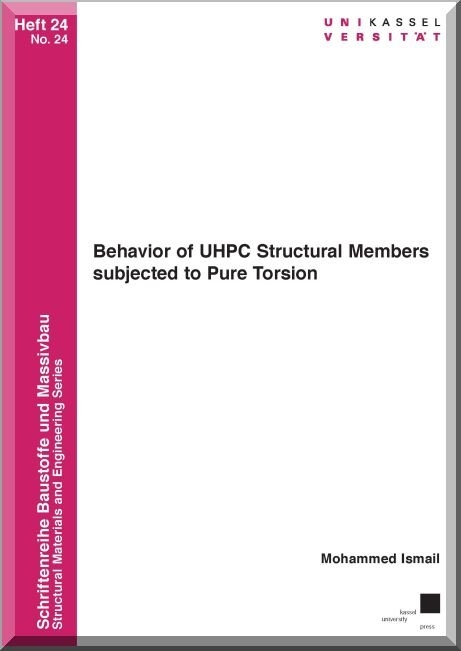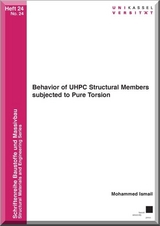Behavior of UHPC Structural Members subjected to Pure Torsion
Seiten
2015
Kassel University Press (Verlag)
978-3-86219-952-5 (ISBN)
Kassel University Press (Verlag)
978-3-86219-952-5 (ISBN)
- Keine Verlagsinformationen verfügbar
- Artikel merken
Ultra High Performance Concrete (UHPC) is characterized by a very high compressive strength which may reach more than 200 MPa. The behavior of this material under tension and compression actions has been established to be very brittle in nature. Discontinuous fibers (normally steel fibers) are usually added to the UHPC mix to introduce ductility.
In order to investigate the beneficial effects of using fiber reinforced UHPC in structural members subjected to torsion, a series of experimental tests on 17 UHPC beams subjected to pure torsion were carried out. The test beams consisted of plain UHPC beams, UHPC beams reinforced with steel fibers only, UHPC reinforced with steel fibers and different combinations of traditional longitudinal and transverse reinforcement. The plain UHPC beams showed very brittle behavior, whereas the UHPC beams with steel fibers only showed a post cracking ductile behavior.
The addition of little steel fiber volume (e.g. 0.5 %) to the plain UHPC beams enhanced the ductility. The enhancement at the ultimate capacity amounts to about 20 %. Meanwhile, the steel fibers with 0.9 % by volume showed much enhanced ductility and a maximum enhancement of the torsional carrying capacity up to 32 %.
The addition of moderate steel fiber volume (e.g. 0.9 %) to one type of traditional reinforcement (either longitudinal or transverse) accomplished an effective post cracking torsional carrying mechanism. The steel fibers shows a tendency to replace the missing type of traditional reinforcement, however this should be confirmed by more tests and by using higher steel fiber volumes.
A series of experimental tests on fiber reinforced UHPC prisms to investigate the post cracking shear strength and stiffness of the used UHPC mix (e.g. M3Q) was conducted. The results of these tests revealed that this fine grained UHPC mix has a weak post cracking shear behavior. The results of these tests were used later in the Finite Element (F.E) model.
An analytical model based on the well known thin-walled tube analogy was developed in order to estimate the torsional carrying capacity of beams under pure torsion having different combinations of steel fibers and traditional reinforcement. The comparison between the test and model results showed very good agreement for all cases.
A finite element model based on calibrated small scale tests was developed using ATENA F.E. package to predict the full load-deformation behavior of the test beams. The predictions of the model show very good agreement with the test results.
In order to investigate the beneficial effects of using fiber reinforced UHPC in structural members subjected to torsion, a series of experimental tests on 17 UHPC beams subjected to pure torsion were carried out. The test beams consisted of plain UHPC beams, UHPC beams reinforced with steel fibers only, UHPC reinforced with steel fibers and different combinations of traditional longitudinal and transverse reinforcement. The plain UHPC beams showed very brittle behavior, whereas the UHPC beams with steel fibers only showed a post cracking ductile behavior.
The addition of little steel fiber volume (e.g. 0.5 %) to the plain UHPC beams enhanced the ductility. The enhancement at the ultimate capacity amounts to about 20 %. Meanwhile, the steel fibers with 0.9 % by volume showed much enhanced ductility and a maximum enhancement of the torsional carrying capacity up to 32 %.
The addition of moderate steel fiber volume (e.g. 0.9 %) to one type of traditional reinforcement (either longitudinal or transverse) accomplished an effective post cracking torsional carrying mechanism. The steel fibers shows a tendency to replace the missing type of traditional reinforcement, however this should be confirmed by more tests and by using higher steel fiber volumes.
A series of experimental tests on fiber reinforced UHPC prisms to investigate the post cracking shear strength and stiffness of the used UHPC mix (e.g. M3Q) was conducted. The results of these tests revealed that this fine grained UHPC mix has a weak post cracking shear behavior. The results of these tests were used later in the Finite Element (F.E) model.
An analytical model based on the well known thin-walled tube analogy was developed in order to estimate the torsional carrying capacity of beams under pure torsion having different combinations of steel fibers and traditional reinforcement. The comparison between the test and model results showed very good agreement for all cases.
A finite element model based on calibrated small scale tests was developed using ATENA F.E. package to predict the full load-deformation behavior of the test beams. The predictions of the model show very good agreement with the test results.
| Erscheint lt. Verlag | 6.5.2015 |
|---|---|
| Reihe/Serie | Schriftenreihe Baustoffe und Massivbau ; 24 |
| Sprache | englisch |
| Maße | 210 x 297 mm |
| Gewicht | 772 g |
| Einbandart | Paperback |
| Themenwelt | Technik ► Bauwesen |
| Schlagworte | analytic model • Bauingenieur-, Vermessungs- und Bauwesen • Finite Element Model • Hochbau und Baustoffe • post cracking shear strength • Stiffness • Technologie, Ingenieurswissenschaft, Landwirtschaf • Torsion • UHPC • Ultra High Performance Concrete |
| ISBN-10 | 3-86219-952-5 / 3862199525 |
| ISBN-13 | 978-3-86219-952-5 / 9783862199525 |
| Zustand | Neuware |
| Haben Sie eine Frage zum Produkt? |
Mehr entdecken
aus dem Bereich
aus dem Bereich
Grundlagen und Vorgehensweisen
Buch | Softcover (2021)
Springer Fachmedien Wiesbaden GmbH (Verlag)
37,99 €
Bemessung von Stahlbauten nach Eurocode mit zahlreichen Beispielen
Buch | Hardcover (2024)
Springer Vieweg (Verlag)
59,99 €
Buch | Softcover (2024)
Springer Vieweg (Verlag)
18,99 €




